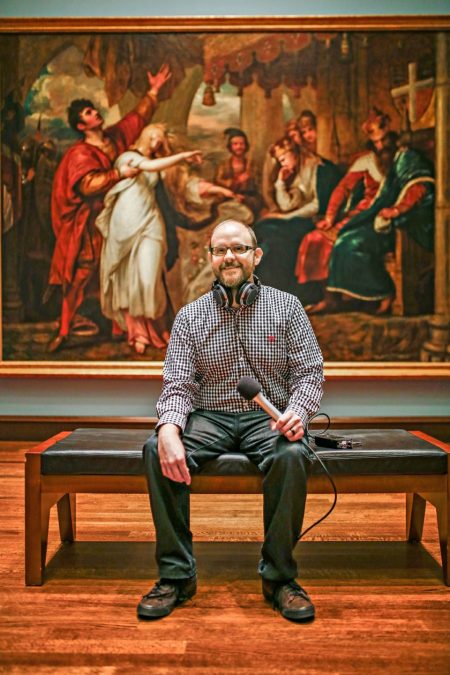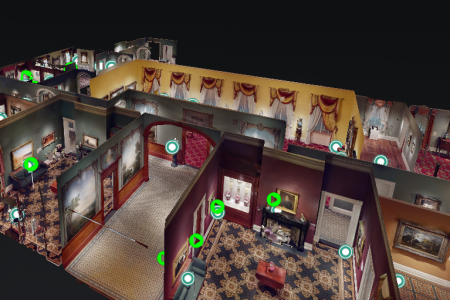The age of digital technology has reached the museums.
When the Cincinnati Art Museum shut down for COVID in March 15, digital programs were launched on March 17.
In 2016, Russell Ihrig, associate director of programming, put his toe in the water and suggested to Emily Holtrop, director, Learning and Interpretation, CAM, that podcasts would be the way to go. You can find the podcast at series https://cincinnatiartmuseum.org/events-programs/podcasts/

Holtrop said, “Russell is irreverent. You can have fun by talking about art and break down the barriers. We had listeners to podcasts in every continent except Antarctica. The podcasts allow people to explore our collection. A primary goal is to engage people in a new way and make them more at ease.”
Ihrig said, “The idea for the podcast came from weekly conversational programs we did around the exhibition 30 Americans. We had an interest in continuing these types of programs, but I thought that making it a podcast would allow us some more flexibility in scheduling our guests and allow more people to hear it than the relatively small group of people who attend in-person talks.”
Ihrig did several podcasts. “In most cases we spent the first part of the show getting to know our guests and learning about what they do. In the second part, we look at a work of art that might have a connection with their work. The goal of these conversations is often to hear their unique perspectives on the artworks.”
For the Cincinnati Ballet podcast, “We looked at our bronze dancers by Degas. With the Cincinnati Symphony Orchestra, we looked at ¾ Time by Judy Pfaff and discussed its musical connections.” For the Cincinnati Opera, which was doing an opera about Frida Kahlo, Ihrig spoke with Catalina Cuervo who was singing the lead in that production. “We looked at photos of Kahlo and from the collection in that episode. I think everyone brings their own unique experiences to the table when they look at art, so I’m always interested to hear how our guests will respond. I always try to keep the conversation casual, because I want it to feel more like you are visiting the museum with friends and less like you’re at a lecture.”
Artists Katie Parker and Guy Michael Davis were the guests for the exhibit Future Retrieval: A Close Parallel, which was a benefit of working with living artists. Ihrig said, “We did two episodes with them that also had video versions as well. The first was about their personal history, artistic process and the ideas behind their current exhibition. The second episode centered around their film influences and related to an online screening that the museum hosted of The Shining.“
Upcoming is an exhibit by Kara Elizabeth Walker, an American contemporary painter, November 5 – January 17. Ihrig will produce a podcast for that show. He will bring in local artists to talk about Walker’s work which centers around issues of diversity, equity and inclusion.
Ihrig has produced over 100 podcasts, but during the pandemic he made fewer because he could not record in the museum for many months. His plan is to create twelve per year. The goal is to make people from the outside more aware of the collection.
New platforms for young people include Instagram, TikTok, Facebook and Twitter.
Ihrig also produced a video with curators responding to video games. “That was something I had always wanted to do as a podcast episode, but I never felt like I had the right opportunity. During the pandemic, our director mentioned that he was interested in exploring ways we could connect with video games, and so it finally ended up being the right time. Since we had already been doing a lot of video projects at that point, it seemed a logical fit to make videos instead of podcasts,” he said.
“I love video games, and often marvel at how these worlds are so intricately designed. Because the goal of many games is to create a believable virtual space, they are often filled with decorative objects. So, I always felt it might be interesting to hear how Amy Miller Dehan, our curator of decorative arts and design, might react to these. After I recorded a couple with Dehan, we did two more with Dr. Ainsley M. Cameron, curator of South Asian Art, Islamic Art and Antiquities,” Ihrig said.
Finally, he recorded two videos with Dr. Kathleen M. Lynch, classics professor at the University of Cincinnati, who was involved in the curation of the antiquities galleries. “We looked at the video game, Assassin’s Creed: Odyssey because it takes place in Ancient Greece, which is her specialty. Lynch had already used this game in some of her classes, so she already understood what we were doing and understood the potential. Lynch was so expressive and enthusiastic that those videos ended up being our most popular.” They had over one million views on YouTube.
Another digital project was CAM Do, art-making-at-home videos geared toward families. Initially, Alex Otte-Calon and Ihrig worked on those. Otte-Calon focused on projects for younger children. Irhig’s focus was school-age children all the way up through adults. Some of those were projects that related to exhibitions, for example, collage for Romare Bearden and caricatures for Frank Duveneck. Others were just fun projects that we thought people might enjoy, like drawing monsters based on random dice rolls. “Both Alex and I had to take a break from those as we began doing more in-person programs in the building, but my plan is to continue these on a monthly basis throughout the next year,” Ihrig said.
“I think catching people’s attention is the main challenge. Everything online is competing for your attention, so you have to figure out what the hook is and hope it catches,” said Ihrig.
CAM Connect is a Facebook group. Holtrop produces content. For example, there was a feature about national watermelon month in July. Then, the cicadas. CAM Connect held a joint book club with the Cincinnati Museum Center twice a week at 11 a.m. Museum staff moderated the session which attracted about ten people. Visitors could go back and look at it. But, the idea fizzled. As a result, the museum no longer offers it.
Ihrig said, “We work closely with the Marketing Department and see digital programming as an extension of public programming.” Holtrop is working on bringing lectures online in the auditorium.
The staff is open to experimentation and getting people comfortable with technology. “People are sick of sitting behind the screen,” Holtrop said. “I have done more videos from my dining room to get the content out there. It humanizes people even more. It’s a whole new world. It’s exciting to have new challenges.”
CAM Breathe is a program led by Rachel Moore, administrative assistant, with videos of yoga.
CAM Access is a verbal description for blind and visually impaired. Holtrop said they can pull from the vast quantity of pieces from the digital collection, not just shown on the walls. It enables the visitors to get an idea of the depth of the collection and show its diversity. There are every type of media represented at the museum. “We want to make people proud of our museum,” Holtrop said. A large amount of the collection is online, but not all of it.
CAM Look features discussion every week. For example, staff members talk about the Paintings, Politics and Monuments Men exhibit. CAM Look is also used in classrooms of high schools and college.
There were some additional skill sets that the staff and docents had to pick up. Holtrop said they are more comfortable with doing things online, and the docents are not camera shy. She has also taught herself video editing.
As the museum has reopened, people are still coming to see shows even though there is some virtual activity. The die-hard museum fans are still going strong. “They can still engage even with accessibility issues,” said Holtrop.
There was a biweekly call-in which CAM staff could ask questions. This, too, lost steam and was discontinued.
Holtrop’s parents were teachers so she went to museums as a child. She ended up loving history and majored in public history at Western Michigan University. She received her MS in architecture from University College in London and realized art museums were her path.
Another museum which has focused on digital technology is The Taft Museum of Art. Elise Solomon, director of learning and engagement, said, “Everything we did before, such as lectures, workshops and school programs, we did digitally. We wanted to get to people and offer teachers a variety of ways to use our content. We had great success with digital programs. We reached people nationally.”
That said, Solomon said it was challenging as “We’re all trying to quickly learn the new technology to match it with the audience. We use Global Business Solutions for our technical needs. We have to adapt again. We’re ready for the leaps and are ready to continue.”
Lunch and Learn has moved to virtual programs. The audience enjoys the format. “It is a great platform and more accessible,” Solomon said.
There is fatigue, however, with virtual programming, according to Solomon, although the museum offers virtual membership.
In April, there was a Duncanson-in-residence virtual fashion show. It showcased a variety of works and appeared on Facebook Live.
The bulk of the digital programming comes from the Education Department. There is an online talk with curators about the exhibit “In a New Light: Treasures from the Taft” which appears in the Fifth Third Gallery.
Another example of digital programming is a 360-walk through of the historic house virtually. A special camera was used to create this. : https://taftmuseum.regfox.com/self-guided-virtual-tour-taft-historic-house

Local and regional specialists with different target audiences offer an array of programs that are more academic and light-hearted. A core audience varies from program to program as the museum tries to make it more relevant.
Solomon said, “I am an enthusiast. Art is for everybody.” She likes The Taft and views it as a gift to the community. “We’re trying new things,” she added.
School programming is going to reach hundreds of students with synchronous and asynchronous programming. Synchronous classes run in real time, with students and instructors attending together from different locations. Asynchronous classes run on a more relaxed schedule, with students accessing class materials during different hours and from different locations. There will also be a program for underserved schools.
“At the beginning of the pandemic, it was an escape,” Solomon said. “We had to figure out what the next step is. As a nonprofit with a limited budget, the Taft can’t produce TV videos. We use platforms like Zoom and PowerPoint. As the director of a department of four employees, Solomon must make the decision about where she puts different resources.
Solomon responds to the environment that she finds ourselves in. She said, “I think we will continue to consider offering many of programs like school tours and talks in a virtual format, or even more ideally, finding a hybrid model that works for us.”
–Laura A. Hobson



